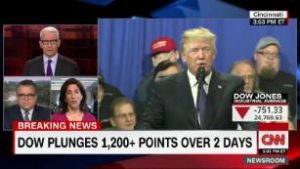Why stock market upheaval was inevitable
(CNN)The sharp plunge in stock markets around the world earlier this week tells us that major central banks, with the US Federal Reserve at the forefront, have severely underestimated the risk of keeping interest rates too low for too long. Now that markets expect higher rates — due to improved economic growth, higher inflation, growing fiscal deficits, and the unwinding of central bank balance sheets — it has become clear that monetary stimulus created a pseudo wealth effect, and that suppressing interest rates by unconventional policy to spur risk-taking and pump up asset prices was itself a risky strategy.
 The long stock market rally since 2009 was fueled in large part by the Federal Reserve’s unconventional monetary policies. By promising to keep its policy rate (the federal funds rate) near zero “for a considerable period of time” and engaging in large-scale asset purchases, known as “quantitative easing,” the Fed hoped to boost asset prices and stimulate the economy.
The long stock market rally since 2009 was fueled in large part by the Federal Reserve’s unconventional monetary policies. By promising to keep its policy rate (the federal funds rate) near zero “for a considerable period of time” and engaging in large-scale asset purchases, known as “quantitative easing,” the Fed hoped to boost asset prices and stimulate the economy.A law of the market is that when interest rates fall, asset prices rise. As long as markets believe the Fed will support asset prices by keeping rates low, stocks will be the investment of choice, rather than conservative, low-yield saving accounts, money market funds, or highly-rated bonds.
But now it seems markets don’t believe those helpful Fed policies will last much longer. The uptick in economic growth forecasts, the expectation of higher inflation, and the growing federal deficits are putting pressure on the Fed to increase the pace of their policy rate hikes. Markets are now factoring in those forces and the realization that stock prices are not on a sustainable path — hence a big sell-off.
Such a downturn was inevitable, because reality tells us that there has been a mismatch between the economy and the stock market. Fed policy did not — and could not — permanently increase real economic growth and wealth. If it could, then the best policy would be to simply run the money printing presses day and night. When stock prices increase by double digit percentages for more than seven years while economic growth is sluggish (last year the Dow increased by 25% and the economy grew by less than 3%), something is amiss.
And we’ve seen what happened to the market in previous instances when it seemed like the Fed was going to change course. In 2013, when Fed Chairman Ben Bernanke indicated he might start exiting QE — decreasing the support for stocks — markets dropped sharply in the famous “taper tantrum.” Bernanke quickly reassured markets that the low-rate policy and QE would continue, and markets resumed their upward trend.
The fear now is that the new Fed chairman, Jerome Powell, may have to quicken the pace of interest rate hikes and speed up the unwinding of the Fed’s huge portfolio of mortgage-backed securities and longer-term Treasuries, or else the Fed will lose control of its ability to manage inflation. Given the inverse relationship between interest rates and asset prices, investors rightfully are looking to reduce the weight of stocks in their portfolio before rising rates cut into the gains made over much of the last decade.
And there are other factors that may push up interest rates, and push equity prices down in the process. There is the expectation that with President Trump’s $1.5 trillion tax cut and plans for increased spending, fiscal deficits will grow, leading to higher interest rates as the government enters the bond market to cover its deficit spending. Floating more bonds will decrease their prices and increase their yields, attracting more investors into bonds and out of stocks.
The only sure path toward future prosperity is to let free markets determine interest rates and the allocation of credit. Private saving finances productive investment that increases future real income and consumption. That linkage is an iron law of economics.

Leave a Reply